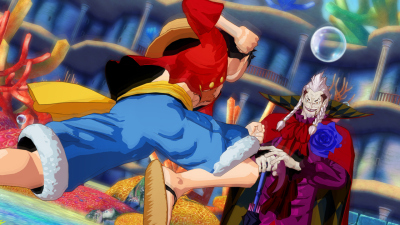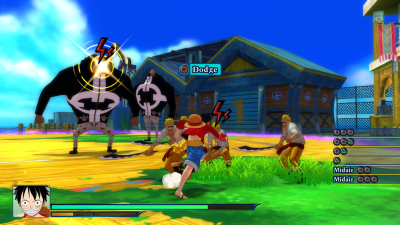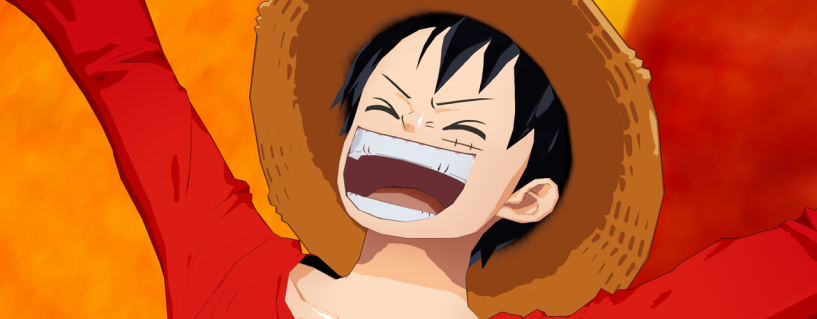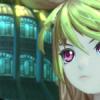Last year, one of my friends set out to watch all of One Piece, up to and including the episodes airing at the time—some 600 individual episodes. To make this more manageable on his uni break, he watched each episode at double speed. One Piece Unlimited World Red makes me wish I could do the same—fast-forward through the tedium to enjoy those rare golden moments. As an action-adventure game, I expected adrenaline-pumping combat a la the Dynasty Warriors series combined with the adventuring and platforming aspects of something like Jak and Daxter. What I got was some surprisingly enjoyable mini-games sandwiched between long stretches of mediocrity.
Videogame adaptations are notorious for attempting to compensate average gameplay with pandering to fans and One Piece Unlimited World Red is no different. I approached the game with only a mild awareness of the series, thanks to around two dozen episodes under my belt and general trivia I picked up online. I was no stranger to (most of) the Straw Hat Pirates but there were going to be missed references—and I was more than happy to make allowances for that.
 But the “original plot” the game boasts is original in the same way that Kingdom Hearts is original. Plot-lines are ripped and recycled from the anime, only with a new villain masterminding the whole affair. Antagonist Patrick Redfield is an old, washed-up pirate who apparently mixed it with legendary pirates Gold Roger and Whitebeard—which means nothing to those who aren’t familiar with the show. He creates clones of famous One Piece villains and locations for… some reason. Redfield’s ultimate motivation is to acquire a Devil Fruit that will turn him into a vampire, thereby granting him eternal youth and making him feel better about never getting the limelight in his hey-day. But his actions—cloning dudes and impeding the Straw Hat Pirates—have absolutely no effect on this ambition.
But the “original plot” the game boasts is original in the same way that Kingdom Hearts is original. Plot-lines are ripped and recycled from the anime, only with a new villain masterminding the whole affair. Antagonist Patrick Redfield is an old, washed-up pirate who apparently mixed it with legendary pirates Gold Roger and Whitebeard—which means nothing to those who aren’t familiar with the show. He creates clones of famous One Piece villains and locations for… some reason. Redfield’s ultimate motivation is to acquire a Devil Fruit that will turn him into a vampire, thereby granting him eternal youth and making him feel better about never getting the limelight in his hey-day. But his actions—cloning dudes and impeding the Straw Hat Pirates—have absolutely no effect on this ambition.
The writing isn’t great then. One of the early surprises is painfully obvious at least a full chapter before it’s revealed. The finale features a poignant point about not letting fear and old age stop you from striving for your dreams… but delivers it in the gratuitous pseudo-philosophical monologue form typical of many anime. On the other hand, much of the dialogue is full of witty one-liners; skeletal musician Brook is the best of the bunch, with numerous wisecracks about his near-death experiences or non-existent muscular system.
The complete detachment between the dungeons and the overarching plot makes the dungeons feel like padding, an excuse to make you fight enemies and create an illusion of length and challenge. That wouldn’t matter so much if the actual gameplay was up to scratch; sadly, while it shows occasional flashes of depth and potential, One Piece Unlimited World Red too often stumbles over itself - a fact not helped by some over-enthusiastic padding that crams in a large array of options and systems but struggles to provide them with a meaningful place.
One Piece features a rubber dude, a shape-shifting reindeer, and a guy who wields a sword in each hand and in his mouth. With that sort of variety on offer, you’d be forgiven for thinking that the game catered for a wide variety of playstyles and involved a decent agree of tactical depth, even bearing in mind the developer’s need to remain accessible. Unfortunately, even with that kind of potential, Unlimited World Red’s combat is bland. Each of the nine Straw Hat Pirates has an interesting and unique move-set and can create combos using the Square and Triangle buttons; but the enemies lack the kind of balanced challenge you might expect of a brawling action RPG. Regardless of who you are playing as, foes are easily defeated simply by mashing buttons - though often these battles can become a grind rather than a challenge.
The Straw Hat Pirates should be fun to fight as; unfortunately, the uninspiringly palette-swapped enemies take far too much of a beating to allow you the satisfaction of plowing through them like you do in Dynasty Warriors. Boss fights do little to change this. A slight difficulty increase comes from increased damage and health, as well as unblockable attacks, but even with the increase I didn’t need to heal mid-battle until well over halfway through the 10 or so hours it takes to complete the story.
Thankfully, adventuring is much more entertaining, though suffers from its own problems - notably pacing issues. The Straw Hat Pirates find themselves in the awkwardly named Transtown and Luffy inadvertently volunteers to transform it into a respectable city. Thus begins an almost entirely pointless diversion consisting of collecting materials to upgrade buildings so you can acquire better material-collecting abilities.
The realization that I was fishing to unlock a better fishing rod was almost as confusing as the realization that I didn’t care; the simple rhythm mini-game is one of the most relaxing and enjoyable experiences in Unlimited World Red, but ultimately it feels superfluous. It’s a problem shared by many of the game’s features: they’re present, but they never feel necessary to progress, or satisfying, and their rewards aren’t enticing enough to keep you engaged in them.
 Navigating Transtown with Luffy’s Gum Gum Rocket would be a blast if not for the borderline broken camera and imprecise auto-targeting when you’re between buildings. Outside of fishing or bug catching, there’s little to do outside of town and the environments - while admittedly quite beautiful, with visuals which bring to mind The Legend of Zelda: The Wind Waker with their vibrant colors and cel-shaded renderings - are small and fairly linear. It feels like a hollow shell of a game, only partially salvaged by my personal enjoyment of catching 30-odd-meter balloon octopuses and the fact that it looks nice.
Navigating Transtown with Luffy’s Gum Gum Rocket would be a blast if not for the borderline broken camera and imprecise auto-targeting when you’re between buildings. Outside of fishing or bug catching, there’s little to do outside of town and the environments - while admittedly quite beautiful, with visuals which bring to mind The Legend of Zelda: The Wind Waker with their vibrant colors and cel-shaded renderings - are small and fairly linear. It feels like a hollow shell of a game, only partially salvaged by my personal enjoyment of catching 30-odd-meter balloon octopuses and the fact that it looks nice.
One Piece Unlimited World Red is clearly designed for true fans then, rather than true gamers. The art style keeps things close to the anime and manga, and the voice acting is purely in Japanese, adding to the authentic feel. But even a game designed to appeal to the fans still needs to offer an engaging gameplay hook, and on that front the game falls down. One of the most egregious oversights is found when Luffy inadvertently falls into the waters around Transtown. In the anime, Luffy becomes paralyzed by sea water; in Unlimited World Red, the screen simply fades to black and he reappears on dry land with absolutely no penalty. With such a lack of consequences, the better - and less lore-defiling - option would have been to create invisible walls around Transtown. Yes, One Piece Unlimited World Red is a game that would actually be improved by invisible walls - one of the cardinal sins of game design. I never thought I’d ever say that, but there it is.
Videogame adaptations sometimes get away with being average by creating an enjoyable fan experience. In this regard at least, and we have no doubt that avid fans will still get plenty of entertainment out of it. In this regard at least, Ganbarion has done a good job of cramming in plenty of references to the series and bringing the personality of its characters to life. In fact, the most enjoyable aspects are the peripheral diversions and the witty dialogue, and admittedly there is plenty of charm to be found in the presentation; but these are hardly unique features in the face of so much competition.
If you want to go fishing or do gardening, go play Animal Crossing. If you want to enjoy the witty dialogue, go watch the actual One Piece anime - perhaps at double speed. But if you want an enjoyable, satisfying RPG-lite action-adventure, you won’t find it here. One Piece Unlimited RED is admittedly great fan service, but it’s not a great game.







